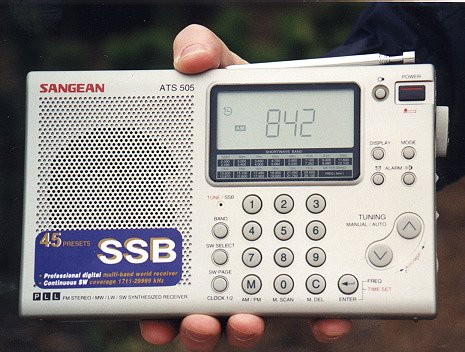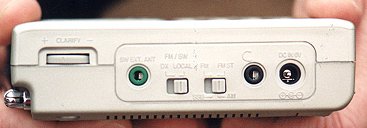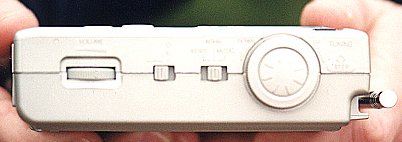
Year Introduced March 2000
Power 6 Volts DC (4 AA batteries). AC adaptor optional.
Size 128 by 214 by 39 mm (5 x 8.5 x 1.5 in) HWD
Weight 840 g (27 oz) without batteries
Price €143, US$130, CAN$200. AC adapter US$9.
Coverage LW 153-279 kHz, MW 520-1,710 kHz, SW 1,711-29,999 kHz, FM 87.5-108 MHz
Value Rating: 



This review was compiled independently. The Medium Wave Circle and Radio Netherlands has no financial connection with Sangean, the manufacturer of this receiver.
Reviewers: Tom Sundstrom
Sangean is one of the world’s largest manufacturers of portable radios, providing a number of portable receivers that range in price from US$90 to US$270 (street prices).
Sangean launched the ATS-505 in the USA during March 2000. It is an affordable radio offering good performance and some features of more expensive radios.
INTRODUCTION
The titanium matte finish ATS-505 (centre) is larger then the ATS-404 (left) and slightly smaller than the ATS-909 (right).

The ATS-505 covers LW from 153 to 279 kHz, AM from 520 to 1710 kHz, shortwave from 1711 to 29999 kHz – including SSB mode – and FM (87.5-108 MHz). By comparison, the ATS-404 omits LW altogether and SW coverage is slightly less, from 2,300 to 26,100 kHz; it also lacks the SSB mode. The ATS-909 covers from 150 to 29,999 kHz, whereas the ATS-505 lacks coverage from 280 to 519 kHz.
The ATS-505 display can show either the frequency or the time in 12 or 24 formats. Two clocks are included, but they must be set separately. The manual doesn’t tell you to set the time in 12-hour format: enter the numbers, press the AM/PM button to toggle the selection, and finish by pressing the Enter key. Push the button near the power switch to activate the backlit display for 7 seconds.
Tuning characteristics are similar to the other Sangean portables. The tuning knob is on the right side panel. The up and down buttons are to the right of the direct-frequency-entry keypad, on the front panel. Press the up or down button down for a second or two and the radio will start to scan.
There are 45 memories divided into 5 “pages” of 9 memories each. One page “each” is devoted to LW, MW and FM, two “pages” to SW. To store a frequency, tune the radio to the desired frequency, press the “M” key and then the Enter key. Once all 9 memories on the page are full, you can choose which memory to overwrite by pressing one of the numeric (1-9) keys.
THE SIDE PANELS
On the sides of the ATS-505 there are a number of switches and knobs.

From left to right, the left side panel contains the SSB clarify knob, external antenna jack, the DX-local switch, a dual-purpose switch from FM stereo/FM mono and SSB-AM, earphones and a DC input jack.
The SSB clarifier varies the tuning +/- 1.5 kHz. There is a detent position, a nice touch for tuning in broadcasters using the SSB mode. All we had to do was change from AM to SSB to listen to the broadcast. No adjustment of the clarifier was necessary.
FM stereo is through the earphone jack only.
The right side panel, from left to right, has the volume control, the tone switch, the lock switch and the tuning knob.

The tone switch offers three settings: music, normal and news. We opted to set the control to music. The lock switch prevents receiver settings by accidentally pressing a key, including ensuring the power remains off while the radio travels in a stuffed suitcase.
The tuning knob defaults to 5 kHz steps, but a push on the knob toggles the step down to 1 kHz.
WHAT ELSE?
One key on the receiver puzzled us until we read the manual. Press the Mode key and the display shows a left- and right-bracket – [ ] – without any hint of what to do next. The 5 key, either the 0 (zero) or 1 key and the Enter key toggle (1) between FM 100 and 200 kHz tuning steps; (2) MW 9 and 10 kHz tuning steps; (3) the 12 or 24 hour clock format; and (4) toggling the beep tone off or on. Press the Mode, 5, 0 and Enter keys in turn to rearrange the memories from low to high frequencies. Do not lose the manual.
On the LW, MW and FM bands (but not on SW), simultaneously pressing the tuning up and down buttons activates the Auto Preset System (APS). Like the ATS-909, the ATS-505 populates the memories with the 9 strongest signals found on the selected band. Given a crowded MW band at night, it does not take very long to populate the MW memories.
The auto memory scans every memory preset and plays each in sequence for 7 seconds.
The back of the radio has a tilt stand, but we didn’t completely trust the durability of the hinge. Further, the radio is wider and taller than it is deep. We were afraid to stand the radio upright as it might tip over, especially with the whip antenna extended. We used a third-party Plexiglas receiver stand to ensure there would be no accidents.
The radio has the obligatory sleep timer and alarm. The sleep timer choices vary from 15 minutes to 2 hours. Set the single alarm time, and choose to wake either to the radio – to the last station selected – or the alarm beep in what Sangean calls the Human Wake System (HWS). We wonder where that creative name came from? May be it should be Humane Waking System, since the alarm gradually gets louder when activated. The radio, upon awakening at the alarm setting, will operate for an hour unless there is human intervention.
Bud-type earphones are supplied with the radio, along with a rubberised slipcase that helps to prevent damage to the receiver finish while travelling.
WHAT’S MISSING?
There is no line out jack, so to send audio to a recording device or a digital signal-decoding box requires a Y-cable adapter to additionally plug in earphones. Don’t forget to set the volume level. The earphones disconnect the internal speaker.
Unlike the ATS-909 with three filter settings on SW, the ATS-505 has no filter choice. And there is no ECSS or selectable sideband option to escape from a strong adjacent signal.
TURNING ON AND TUNING IN
Remember this radio was tested for Radio Netherlands on the East Coast of North America, and we used the radio’s whip antenna. Results from European listening tests will follow later in the year.
We first tuned to Radio Sri Lanka signing on at 0030 UT on 15425 kHz. The audio was readable. Admittedly, at the time this station had an above average signal on the east coast of North America, but to hear it on a portable was unexpected. The next afternoon, around 20 UT about 3 hours before local sunset, All India Radio on 7410 kHz gave good reception; 11620 kHz was not readable due to digital signal interference. A number of African stations on the 60-metre band were heard before local sunset, as well as the Voice of Russia’s European service on 7360 kHz.
The 49-metre band with strong signals from Sackville, Bonaire and Antigua always present a challenge to a receiver. We had to move at least 10 kHz away from the powerhouses to get away from the sideband splatter. As there is only one bandwidth filter, this was no surprise.
We explored the MW band too and had to tune away by 20 kHz to drop out the sideband signals of two local 50 kW stations. At night stations from all across the east and central sections of the USA and Canada were heard. On FM, the stereo through earphones sounds, in our opinion, terrific. We tuned across the LW band but could hear no signals.
We handed the ATS-505 to a number of attendees at the March 2000 Winter SWL Festival near Philadelphia, and we had favourable comments on the audio and controls. A few Sangean owners commented on the telescoping rod antenna installation, liking the fact that two screws hold the antenna in place; apparently some older Sangean portables suffered from loose antennas. Others wondered why the SSB was set up as a variable control, rather than a switch to select LSB and USB, before realizing that the radio tunes in 1 kHz steps, and the BFO is required to fine-tune amateur radio and utility SSB signals.
As a final test, we put in a fresh set of four regular (not heavy duty) AA batteries, tuned to a station, set the volume to a “normal” listening level, and left the radio on to determine battery life. The ATS-505 uses a miserly amount of battery current. The batteries lasted 41 hours. The radio is rated at 300 mW audio output power. Depending on the volume setting, higher or lower than our choice, the battery life may differ.
Without a test bench or specifications data sheet, it is impossible to quantify receiver performance just yet. Our perception from the outset is that our ATS-505 is slightly more sensitive than our Radio Shack DX-398 (Tandy’s version of the ATS-909). Your mileage may vary.
CONCLUSION
Through the 1990’s we had searched for an inexpensive portable radio that we could travel with. To lose a US$130 radio to theft or accident is more tolerable than the mid-to-high-end portables that cost two or three times as much. Most, if not all, of the radios we found in the past were missing frequency coverage in the expanded 41-metre band and other WARC-extended bands. Many receivers lacked the SSB mode for listening to broadcasters like HCJB or Radio for Peace International or the occasional forays into the radio amateur or utility bands.
In our opinion, the ATS-505 definitively ends our search. In summary, we like the radio. Though it has no choice of bandwidth filters, no ECSS and no lineout jack, the performance across the MW, SW and FM bands is, simply stated, significantly better than we expected for the money. To be sure, there are portable radios with more features and better performance, but these radios cost significantly more money.
We also believe that the ATS-505 would be a good choice for a first-time purchaser of a shortwave radio.
In the USA, at US$130 the ATS-505 costs just US$40 more than the smaller ATS-404 and significantly less than the full-featured ATS-909, the Sony ICF-7600G and the Grundig YB-400PE.
Accordingly, at this price point versus features and performance, we give the ATS-505 four stars.
This review first appeared on the Radio Netherlands website.